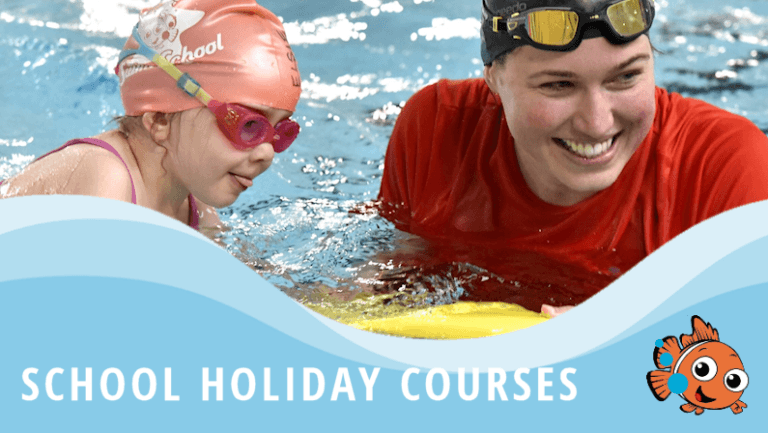“My child is anxious about swimming. How do you help nervous swimmers?”
Learning to swim is an essential life skill that not only promotes physical fitness from baby through to old age, but also builds confidence and ensures safety in and around all areas of water. However, for some children or adults, the idea of swimming can be intimidating and nerve-wracking. At Cindy’s Swim School, we have long understood that to better assist nervous swimmers in overcoming their fears, so that they too can learn how to swim and enjoy the fun that swimming offers, it is crucial to adopt a friendly and helpful approach whilst teaching from a trusted and proven swimming programme.
In this article, I will explain the various strategies and techniques we at Cindy’s have developed to create a supportive environment that encourages nervous children to embrace the water and develop their swimming abilities.
Cindy’s Swim School was founded on a few key core foundations:
-
- Water safety – swimming is a vital life skill that every person should learn!
- Anyone can swim, all they need is someone with the right set of skills to teach them.
- We are insanely passionate about what we do and love ALL things swimming and want to share that love
- We genuinely care about our swimmers, our teachers, the message we are spreading – all of it!
- Everyone should have access to learning how to swim!
I could quite easily talk about all the above points in much greater and deeper detail, but it is Point 2 that I want to focus on; ‘Anyone can swim, all they need is someone with the right set of skills to teach them’ – as this is where the magic at Cindy’s happens 🙂
In today’s world we are so much more clued up and informed about all the different learning styles and abilities there are out there. Learning, and indeed teaching styles, have truly transformed in the last decade. It is now common knowledge that if you want to teach and reach your audience most effectively, you need to incorporate multiple learning styles into your teaching approach. And that is exactly what we do at Cindy’s.
Coming from a dyslexic and dyspraxic background, as well as having experience in near drowning, has given me a particular insight into how best to make swimming, not only accessible, but a safe and joyful place for learning, especially for those who at one time may have been very nervous swimmers!
Now although not everyone has a learning difficulty, being nervous about swimming, having anxiety about what swimming lessons might entail, fears about learning a new swimming technique, or even confronting an exercise that seems out of our reach, are very common and normal feelings to have! This applies whether you are two years old and just starting swimming lessons, a six-year-old struggling with somersaults, or 65 years old and taking the plunge for the first time.
Five golden rules you need to teach a nervous swimmer:
- to be helpful and confident
- to be friendly and fun
- to build trust
- firm boundaries, so that it doesn’t all seem like chaos and terror!
- And you need to know how to teach swimming to different learning abilities 🙂
Nervous swimmers need someone who is not only qualified and experienced enough to navigate them through the journey of learning how to swim, but someone who also has the right amount of empathy and knowledge within their tool set to teach their swimmer how best to overcome any fear and anxiety, and give them the right coping mechanisms so that they can take power of it and manage their fears effectively whenever they may arise.
At Cindy’s, we have created a rather amazing swimming programme that is structured and teaches in a layering flow, which is ideal for those who need a clear and calm learning approach. We also understand that every swimmer is unique, and their fears and learning styles may vary. To cater for all the different learning styles, we provide individualised instruction for specific needs by using the VARK teaching approach. VARK, standing for Visual, Audio, Reading and Kinaesthetic, highlights the main different learning styles. By using this tool, our teachers tailor their teaching approach to suit each swimmer’s personality and learning preferences, ensuring they receive the attention and support they require.
We then further help our nervous and anxious swimmers by using various tools and methods, to teach them the different exercises and strokes. BUT, the first place we always start is…
1. We establish trust and build rapport
The first step in helping nervous children learn to swim is to establish trust and build a strong rapport with our new swimmer/s. We take the time to get to know our new swimmers, to understand their fears, and address any concerns they may have. Our passionate and experienced teachers genuinely care, and teach with empathy and patience, constantly assuring our swimmers that they are there to support and guide them throughout their swimming journey.
2. We create a safe and comfortable environment
We also ensure that we have created a safe and comfortable environment at all our swimming locations, which is crucial for nervous children to feel at ease in the water. We make sure that our swimming areas are free from distractions and potential hazards. Initially, our teachers will give full physical support as they introduce a nervous swimmer to the water. We then gradually and calmly progress the swimmer to using swimming aids such as noodles, which provide additional support and reassurance before moving into deeper or further sections of the pool as their confidence grows.
3. We incorporate fun and playfulness
A big part of our programme foundation is to make swimming lessons enjoyable by incorporating fun and playfulness throughout our lessons. We make use of toys, games, colourful equipment and encouraging communication to engage a nervous swimmer’s interest and make the learning process more enjoyable. For example, if we are teaching a swimmer to pick up a sinker from the step with their face in the water, our teachers will often make a game out of it, distracting a nervous swimmer, so that they get caught up in the fun of the exercise and put their nerves aside. To illustrate, a swimmer might enthusiastically blow bubbles into the water, and put their face in further than they intended, not minding the sensation. By associating swimming with fun, nervous children will be more likely to embrace the water and look forward to their lessons.
Positive reinforcement plays a vital role in helping nervous children overcome their fears, and praising their efforts no matter how small, our teachers build confidence and motivate them to continue learning. This celebration of their achievements and focus on their progress rather than comparing them to others makes such a big difference to nervous swimmers’ self-esteem and learning.
4. We teach the core foundations in a structured format
A big concern for most nervous swimmers starts with breathing technique. Accordingly, this is where we start, so that once mastered, everything our teachers want to teach is easier. Our teachers use special techniques that emphasise the importance of exhaling underwater and inhaling when our face is out of the water. We then practise these techniques in a controlled and supportive environment, gradually increasing the duration of them blowing bubbles as their confidence grows.
5. We break down learning skills and strokes into manageable steps
By breaking down skills into manageable steps, our fun and structured lesson plans then progress to teaching the swimmer the other core foundations of swimming, such as water safety exercises, floating and how to enter, exit and handle oneself safely in and around a pool. Core strength and water independence are then taught until the swimmer is confident and able. We then start to teach the different strokes, beginning with backstroke and front crawl, ensuring that the swimmer builds a strong stroke first, before layering on the next more technically or physically demanding element.
Once our swimmers can swim a strong backstroke and front crawl, they become water-safe. It is from here that we finesse these strokes and teach more co-ordinated strokes and techniques, such as breaststroke, butterfly and tumble turns. Catchy rhythms help the swimmer learn and remember the key elements of each stroke, they are also an amazing tool to help calm nerves and anxiety – a very handy coping mechanism indeed!
6. We are patient and understanding
Patience and understanding are key to teaching anything! They are especially important when helping nervous swimmers learning how to swim. Our teachers recognise that progress may be slow and setbacks are normal. We avoid pressuring or rushing nervous swimmers, as this may further exacerbate their fears. By agreeing a solid plan with the parent, in this case, we focus on building confidence gradually, allowing swimmers to set their own pace, while providing gentle guidance and support.
In summary
By creating a safe and comfortable environment from which to learn, breaking down exercises, strokes and skills into manageable steps, incorporating fun and playfulness, offering individualised instruction with a friendly and supportive approach, we not only empower nervous swimmers to overcome their fears and develop essential swimming skills, but we also teach them all the joys that swimming and being in the water can bring!
 Our Christmas Swim Shop is now open! Original swimming gift ideas from babies to adult learners!
Our Christmas Swim Shop is now open! Original swimming gift ideas from babies to adult learners! 





